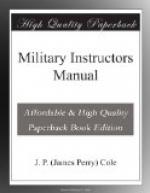12. Discuss uses of the various arms in combat.
Ans.—Infantry: The most important arm, charged with the main work of the battle.
Artillery: Supporting arm of infantry. Its target is the opposing arm most dangerous to the infantry.
Cavalry: Reconnaisance before combat, support of other arms during combat.
13. What is the difference between the attack and the assault?
Ans.—In combat where the force is as large or larger than a division, a simultaneous advance against the entire hostile front is out of the question. Attack is made up of a number of local combats. Some where enemy is engaged with view to driving him out. This is called the assault. Other parts of attack with fewer troops simply to keep the enemy from coming to the support of those troops of the assaulted lines. The entire advance against the enemy is the attack.
After the firing lines have advanced some distance the weak and the strong points of the enemy’s lines are disclosed. The weak points of course are selected.
14. Discuss the manner in which a pursuit should be carried out?
Ans.—If enemy commences withdrawal before front lines have given way, troops in action push forward until enemy in their front are driven away. Cavalry and horse artillery are thrown against flanks of retreating enemy, or on their front. Purpose to further disorganize the enemy, beat him to bridges, defiles, etc. In meantime reserve is sent into the pursuit, while troops engaged are assembling to constitute a new reserve. General scheme is to keep in continuous contact with enemy, giving him no chance to reorganize. Boldness necessary.
15. What are the different kinds of defense, and what is the purpose of each?
Ans.—(a) Passive; to retain position for specified time with or without combat, or to prevent enemy from carrying position.
(b) Defense seeking favorable decision; troops forced temporarily to assume the defensive, with intention of assuming the offensive at first favorable opportunity.
16. What is the purpose of the counter attack?
Ans.—To win victory, stave off defeat or prevent lines from being entered. It may be launched either at the enemy’s strong or weak points depending on conditions. If enemy are beaten off and disorganized at some point, it may be good opportunity to follow up the advantage by counter attack. Also at other points where weakness develops. Counter attack is made at strength of enemy to prevent him from penetrating the defensive position.
17. How should advance position be organized and held?
Ans.—Force should not be so weak that it can be driven back to main body before it accomplishes its purpose, nor so strong that it will hold out too long, thereby committing the entire force to action in advance line instead of the line selected.




